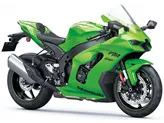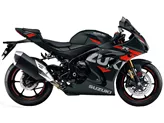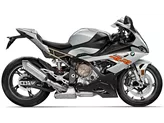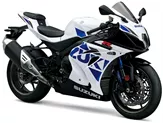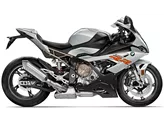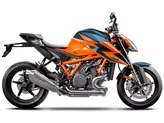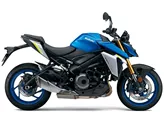Ducati 1199 Panigale S 2012 vs. Suzuki GSX-R 1000 2017

Ducati 1199 Panigale S 2012

Suzuki GSX-R 1000 2017
Overview - Ducati 1199 Panigale S 2012 vs Suzuki GSX-R 1000 2017
The Ducati 1199 Panigale S 2012 and the Suzuki GSX-R 1000 2017 are both high-performance supersport motorcycles with impressive specifications.
In terms of engine and drive train, the Ducati 1199 Panigale S 2012 has a larger bore and stroke compared to the Suzuki GSX-R 1000 2017, resulting in a higher displacement of 1198cc compared to 999cc. However, the Suzuki GSX-R 1000 2017 has a higher engine power of 202 HP compared to 195 HP of the Ducati 1199 Panigale S 2012. The torque of the Ducati is 132 Nm, while the Suzuki has a torque of 118 Nm. The compression ratio of the Suzuki is slightly higher at 13.2 compared to 12.5 of the Ducati.
Both motorcycles feature upside-down telescopic forks for the front suspension. However, the Ducati 1199 Panigale S 2012 has Öhlins suspension with TiN-coating, while the Suzuki GSX-R 1000 2017 has Showa suspension with Big Piston technology. Both suspensions offer compression, preload, and rebound adjustments. The rear suspension of the Ducati is a single swing arm with Öhlins brand, while the Suzuki has a swing arm with Showa brand.

Ducati 1199 Panigale S 2012
In terms of chassis, both motorcycles have aluminum frames. The Ducati 1199 Panigale S 2012 has a monocoque frame type, while the Suzuki GSX-R 1000 2017 has a twin tube, twin-spar frame type.
Both motorcycles have double disk brakes with radial, monoblock technology and Brembo brand for the front brakes.
In terms of advanced rider assistance systems, both motorcycles have ABS. However, the Suzuki GSX-R 1000 2017 offers additional features such as riding modes, ride by wire, and traction control.
In terms of dimensions and weights, both motorcycles have a front tire width of 120mm and a front tire diameter of 17 inches. The rear tire width of the Ducati is 200mm, while the Suzuki has a rear tire width of 190mm. Both motorcycles have a rear tire diameter of 17 inches. The wheelbase of the Ducati is slightly longer at 1437mm compared to 1410mm of the Suzuki. Both motorcycles have a seat height of 825mm and a fuel tank capacity of 17 liters for the Ducati and 17.5 liters for the Suzuki.

Suzuki GSX-R 1000 2017
In terms of strengths, the Ducati 1199 Panigale S 2012 offers plenty of power, a quality traction point, great ABS, electronically adjustable suspension, light weight, and immaculate brakes. On the other hand, the Suzuki GSX-R 1000 2017 has a high-revving engine, no dents in the torque curve, super stability on corner exit and radius, a great quickshifter, high-quality chassis, and performs terrifically on fast tracks.
In terms of weaknesses, the Ducati 1199 Panigale S 2012 has a very high purchase price. The Suzuki GSX-R 1000 2017, on the other hand, does not have an adjustable engine brake.
Overall, both motorcycles offer impressive performance and features, with the Ducati 1199 Panigale S 2012 excelling in power and adjustable suspension, while the Suzuki GSX-R 1000 2017 stands out with its high-revving engine and stability on corners.
Technical Specifications Ducati 1199 Panigale S 2012 compared to Suzuki GSX-R 1000 2017
Pros and Cons in comparison
Pros and Cons in comparison
Ducati 1199 Panigale S 2012

Les acheteurs de la Panigale auront certainement beaucoup de plaisir avec la Ducati, mais en début de saison, il faut justement beaucoup de travail pour trouver des réglages qui fonctionnent. Sur la piste, on est sûr qu'avec suffisamment de savoir-faire dans le sac à dos, la Panigale pourra exprimer tout son potentiel et que les temps au tour seront poussés à un nouveau niveau.
Suzuki GSX-R 1000 2017

Suzuki a réussi à rendre la GSX-R 1000 2017 géniale. Une moto puissante comme un ours avec une courbe de couple incroyablement douce. Incroyable avec 202 ch ! Le châssis est de grande qualité et l'électronique n'a pas de paillettes, mais elle offre des performances exceptionnelles.
Price Comparison Avarage Market Price Ducati 1199 Panigale S vs Suzuki GSX-R 1000
There are a few key differences between a Ducati 1199 Panigale S 2012 and a Suzuki GSX-R 1000 2017. There are the same number of bikes of both models available on the 1000PS.de marketplace, specifically 4. It takes less time to sell a Ducati 1199 Panigale S with 96 days compared to 121 days for a Suzuki GSX-R 1000. Since model year 2012 1000PS.de editors have written 4 reviews for the Ducati 1199 Panigale S and 71 reviews for the Suzuki GSX-R 1000 since model year 2005. The first review for the Ducati 1199 Panigale S was published on 6/15/2012 and now has more than 24,800 views. This compares to more than 7,100 views for the first review on Suzuki GSX-R 1000 published on 3/3/2004.


